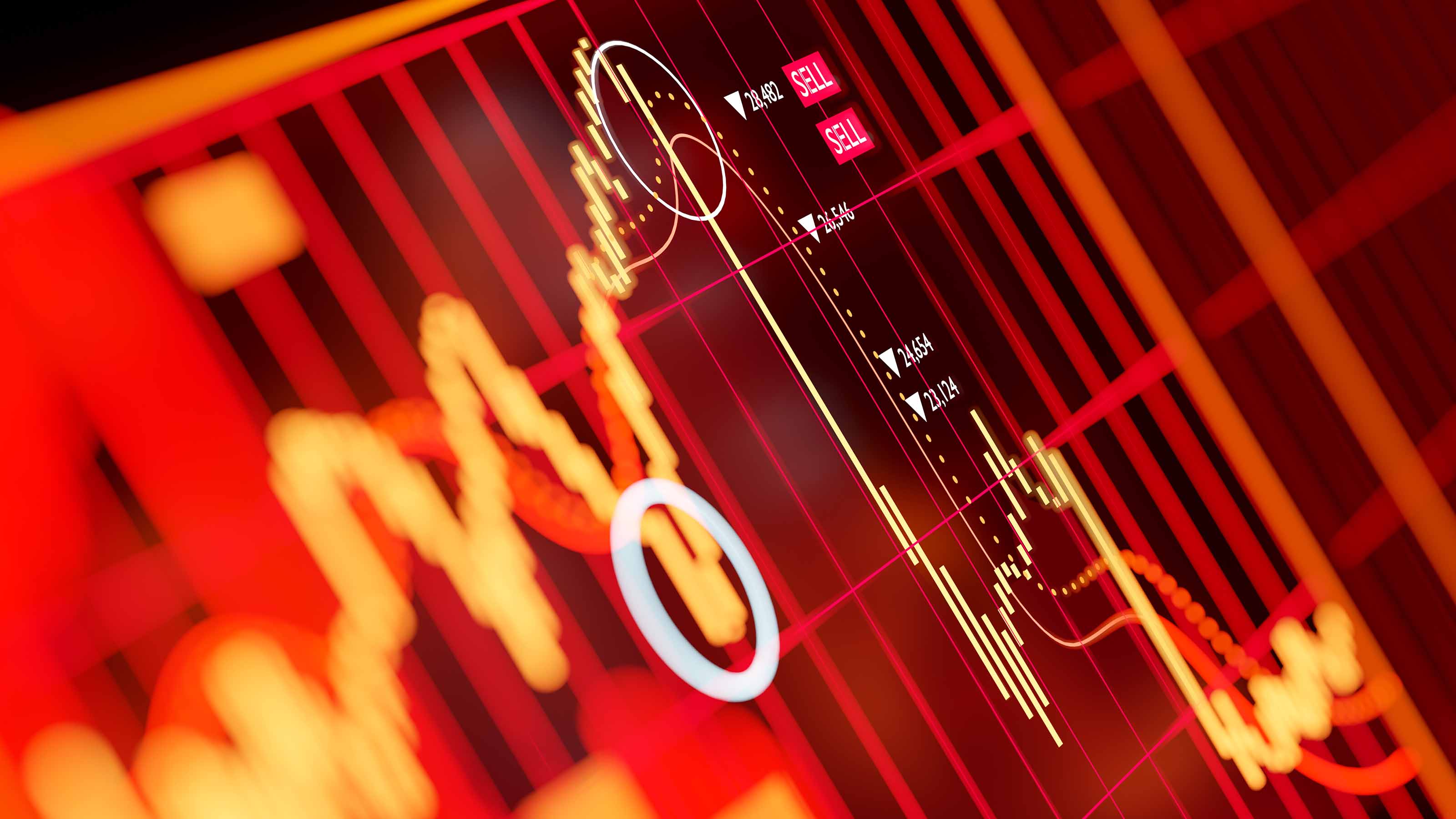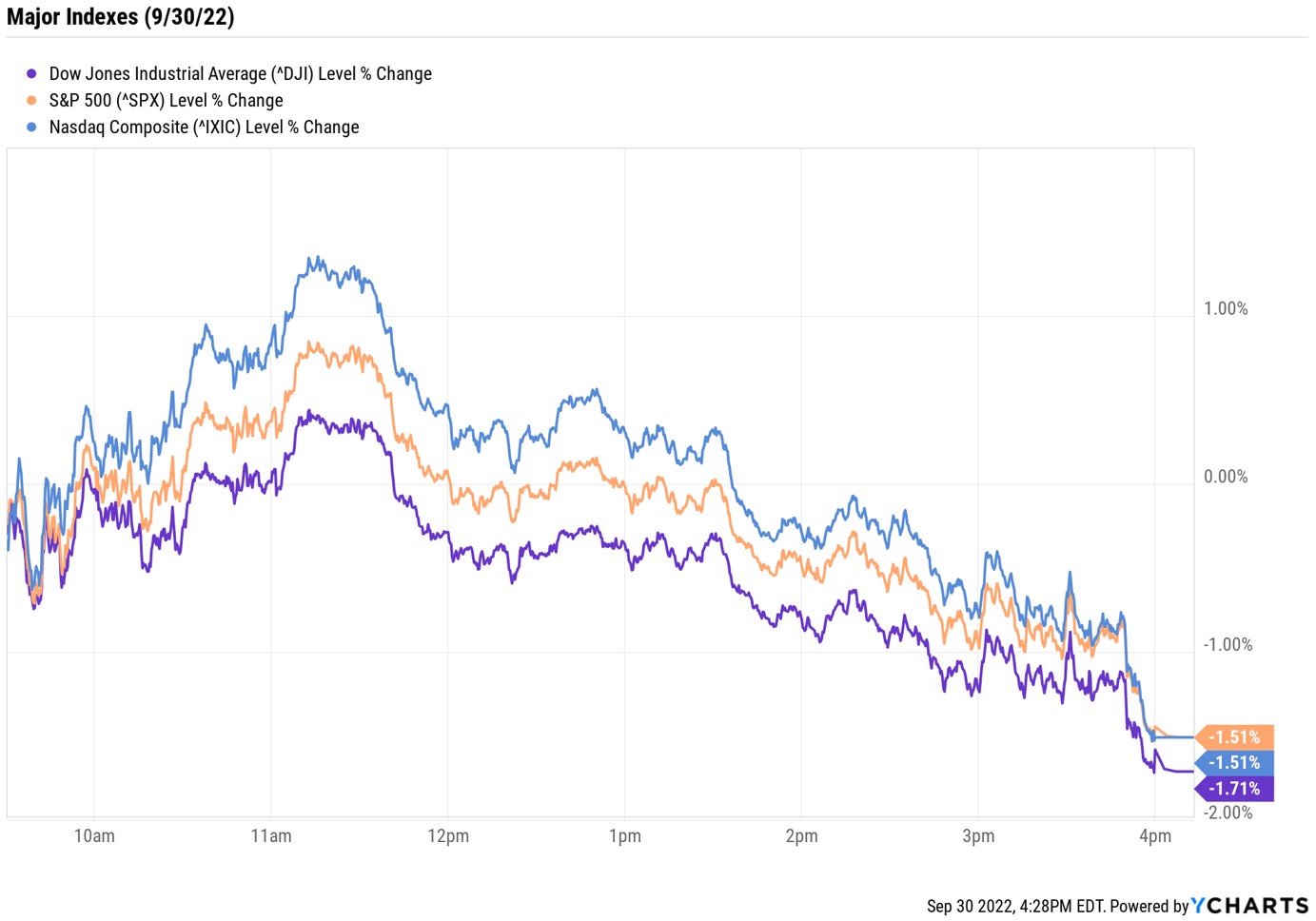Stock Market Today: Stocks Sell Off to Close a Disastrous September
The stock market's latest slide occurred as inflation data came in hotter than expected.


It was a fitting end to what turned out to be a tough week, month and quarter for stocks, with the negative price action driven by fears of Fed rate hikes, stubbornly high inflation and a slowing economy.
Stocks started Friday in the red after this morning's personal consumption and expenditures index, which measures price changes for household spending and is the Fed's preferred measure of inflation, came in higher than expected. Specifically, data from the Commerce Department showed core consumer prices, which exclude volatile food and energy prices, were up 0.6% month-over-month and 4.9% year-over-year in August.
However, stocks pared some of these losses after the Chicago purchasing managers' index slumped to 45.7 in September from August's 52.2. Readings below 50 indicate contraction, and this the index's lowest level in two years.

Sign up for Kiplinger’s Free E-Newsletters
Profit and prosper with the best of expert advice on investing, taxes, retirement, personal finance and more - straight to your e-mail.
Profit and prosper with the best of expert advice - straight to your e-mail.
"There were two waves of U.S. economic data, the first suggested inflation remains hot and more Fed tightening pain is justified, while the second wave showed a weakening economy and some relief with inflation expectations," says Edward Moya, senior market strategist at currency data provider OANDA.
Still, the mid-morning push higher couldn't be sustained, and by the close, the Dow Jones Industrial Average was down 1.7% at 28,725, the S&P 500 Index was off 1.5% to 3,585, and the Nasdaq Composite was 1.5% lower at 10,575. This capped off a terrible week for the indexes, whose losses were each around 3%. The monthly declines were even steeper, with the Dow sliding 8.8%, the S&P sinking 9.3% and the Nasdaq spiraling 10.5%. All three finished the quarter deep in the red, too.

Other news in the stock market today:
- The small-cap Russell 2000 slipped 0.6% to 1,664.
- U.S. crude futures shed 2.1% to finish at $79.49 per barrel.
- Gold futures gained 0.2% to settle at $1,672 an ounce.
- Bitcoin ticked up 0.2% to $19,463.96. (Bitcoin trades 24 hours a day; prices reported here are as of 4 p.m.)
- Nike (NKE) plummeted 12.8% today, easily making it the worst Dow Jones stock. Weighing on the stock was the athletic apparel retailer's warning that it accumulated an excess of inventory, which it will look to "aggressively liquidate," said Matthew Friend, chief financial officer at Nike. This overshadowed NKE's stronger-than-expected fiscal first-quarter results. "Our view is Nike's Consumer Direct Acceleration strategy is the right one and its China business will continue to rebound," says UBS Global Research analyst Jay Sole. "These are key tenets of our Buy thesis and Nike's first-quarter result didn't give us a reason to change our view on these issues. Plus, Nike's 10% ex-forex year-over-year Q1 sales growth and ~20% fiscal second-quarter ex-forex y/y sales growth guidance give us increased conviction consumer demand for Nike remains robust."
- Generac Holdings (GNRC) rose 2.3% after analysts at Cowen initiated coverage on the stock with an Outperform rating, which is the equivalent of a Buy. The analysts said the maker of generators is "the clear industry leader within a market that still has growth potential." They add that the "instability of the grid continues to drive significant power outages across the U.S. during periods of extreme weather. We believe the clear need for incremental grid investment and hardening has increased baseline demand for Generac's products."
Buffett Buys More OXY. Should You, Too?
A bright spot amidst this selling: Occidental Petroleum (OXY), which rose 4.7%. While some tailwinds came from broader strength in the energy sector (+2.3% for the week), the integrated oil and gas stock also got a little help from none other than Warren Buffett himself.
A recent regulatory filing revealed Buffett's Berkshire Hathaway (BRK.B) bought 6 million more shares of OXY between Sept. 26 and Sept. 28. This brings the holding company's total stake in Occidental to 21%, solidifying its spot as the top shareholder.
Berkshire's been accumulating OXY shares hand over fist in recent months, leading many to wonder if Buffett will eventually just buy the firm. "We continue to believe an outright total purchase of OXY in the near-term could make logical sense for Berkshire Hathaway given the Low Carbon Ventures progress, rapidly shrinking leverage, strong free cash flow forecast, and approaching investment-grade rating status," says Truist Securities analyst Neal Dingmann.
And as Berkshire keeps buying Occidental shares, many investors might be wondering if they should follow suit. Here, we explain why they should think twice.
Get Kiplinger Today newsletter — free
Profit and prosper with the best of Kiplinger's advice on investing, taxes, retirement, personal finance and much more. Delivered daily. Enter your email in the box and click Sign Me Up.

With over a decade of experience writing about the stock market, Karee Venema is the senior investing editor at Kiplinger.com. She joined the publication in April 2021 after 10 years of working as an investing writer and columnist at a local investment research firm. In her previous role, Karee focused primarily on options trading, as well as technical, fundamental and sentiment analysis.
-
 Before You Remarry: 10 Important Things to Consider
Before You Remarry: 10 Important Things to ConsiderRemarry carefully, because love gets complicated the second time around.
By Jennifer Waters
-
 80-Year Old Dick Durbin, the Senate’s No. 2 Democrat, To Retire After 44 Years in Congress
80-Year Old Dick Durbin, the Senate’s No. 2 Democrat, To Retire After 44 Years in Congress‘In my heart, I know it’s time to pass the torch,’ Senator Durbin said in a statement.
By Kathryn Pomroy
-
 Stock Market Today: Stocks Rise on Good Volatility
Stock Market Today: Stocks Rise on Good VolatilityInvestors, traders and speculators continue to process the "known unknown" of global tariff-and-trade war negotiations.
By David Dittman
-
 Stock Market Today: Trump Retreats, Markets Rejoice
Stock Market Today: Trump Retreats, Markets RejoiceStocks rally, yields soften, the dollar rises, and even beaten-down names enjoy the wages of potential trade peace.
By David Dittman
-
 Stock Market Today: Stocks Soar on China Trade Talk Hopes
Stock Market Today: Stocks Soar on China Trade Talk HopesTreasury Secretary Bessent said current U.S.-China trade relations are unsustainable and signaled hopes for negotiations.
By Karee Venema
-
 Stock Market Today: Dow Drops 971 Points as Powell Pressure Ramps Up
Stock Market Today: Dow Drops 971 Points as Powell Pressure Ramps UpPresident Trump is increasing his attacks against Jerome Powell, insisting the Fed chair cut interest rates.
By Karee Venema
-
 Stock Market Today: No 'Powell Put'? No Problem
Stock Market Today: No 'Powell Put'? No ProblemInvestors, traders and speculators look beyond both another Trump post and more signs of slowing economic activity.
By David Dittman
-
 What Is the Buffett Indicator?
What Is the Buffett Indicator?"It is better to be roughly right than precisely wrong," writes Carveth Read in "Logic: Deductive and Inductive." That's the premise of the Buffett Indicator.
By Charles Lewis Sizemore, CFA
-
 Stock Market Today: Dow Drops 699 Points After Powell Speech
Stock Market Today: Dow Drops 699 Points After Powell SpeechFed Chair Powell warned of a slowing economy and higher inflation but said the central bank isn't ready to cut rates just yet.
By Karee Venema
-
 Stock Market Today: Stocks Struggle Amid Tariff Uncertainty
Stock Market Today: Stocks Struggle Amid Tariff UncertaintyBoeing dropped after China suspended new aircraft orders, while Bank of America and Citi climbed on earnings beats.
By Karee Venema